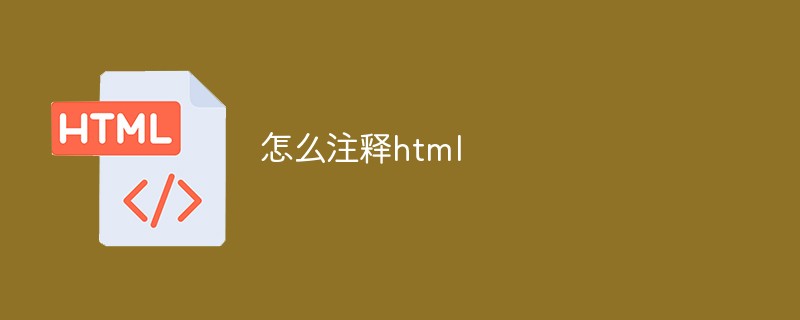Home >Web Front-end >Front-end Q&A >How to annotate html
In HTML, you can add comments through the "8d0d9f613ee4a9219a4d7a4cb67e7ad3" tag; comments will not be displayed on the page, but they can be used to remind web designers to recall related procedures. Information; the comment line is written like "ebdd39e72ad66847060b3cc97d3dfd66]-->".

The operating environment of this article: Windows7 system, HTML5&&CSS3 version, DELL G3 computer
HTML comments
Code that is not executed by the program. It is used by programmers to mark code, which is helpful for later modifications and learning by others
8d0d9f613ee4a9219a4d7a4cb67e7ad3 The comment tag is used to insert comments and comments in the source document Will not be displayed in the browser.
We often have to make some HTML comments next to some codes. This has many benefits, such as: it facilitates other programmers in the project team to understand your code, and it also facilitates your understanding and understanding of your own code in the future. Modifications, etc.
You can add your own comments to the HTML document. Comments are not displayed on the page and can be used to remind web designers to recall relevant program information. The comment line is written as follows:
<!--The following table gives us precise control of figure placement.-->
Note: There must be two hyphens after the exclamation point and two hyphens before the greater than sign. Some browsers strictly check this.
Basic syntax of HTML comments
<!--comment[<%=expression%>]-->
Example 1
<!--Thisfiledisplaystheuserloginscreen-->
Generate the same data as above in the client's HTML source code:
Example 2
<!--Thispagewasloadedon<%=(newjava.util.Date()).toLocaleString()%>-->
is displayed in the client's HTML source code as:
<!--ThispagewasloadedonJanuary1,2000-->
Description
This kind of comment is very similar to HTML, That is, it can be seen in "View Source Code".
Somewhat different is that you can use expressions in this comment (shown in Example 2). This expression is indefinite and is determined by the page Different to different, you can use various expressions, as long as they are legal. For more information, please see the expressions
// and /* */ are also commonly used comments in html, but they can only be used in js and CSS languages and do not work in HTML languages!
The role of comments
As you can see, the content commented with "9f9091322f187259b3af9befdc60c2f1" will not be displayed in the browser. The comment tag is used to insert comments in the source code, and the content of the comments will not be displayed in the browser. Commenting the key code will help you understand the source code you wrote at that time in the future.
When writing HTML code, we often need to make comments next to some key codes. This has many benefits, such as: it is easier to understand, easier to find, or easier for other programmers in the project team to understand your code. , and it will make it easier for you to modify your code in the future.
Commenting critical code is a good habit. When developing a website or functional module, code comments are particularly important. Because the code at that time was often hundreds or even thousands of lines, if you did not comment on the key code, you would often feel dizzy and even unable to understand the code you wrote at that time.
Recommended learning: "HTML video tutorial" "css video tutorial"
The above is the detailed content of How to annotate html. For more information, please follow other related articles on the PHP Chinese website!